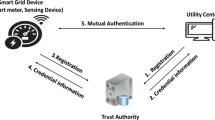Abstract
We propose an Interactive Message Authentication Protocol (IMAP) using two channels; an insecure broadband channel and an authenticated narrow-band channel. We consider the problem in the context of ad hoc networks, where it is assumed that there is neither a secret key shared among the two parties, nor a public-key infrastructure in place. The security of our IMAP is based on the existence of Interactive-Collision Resistant (ICR) hash functions, a new notion of hash function security. Our IMAP is based on the computational assumption that ICR hash functions exist. It performs better than message authentication protocols that are based on computational assumptions. That is, while achieving the same level of security, the amount of information sent over the authenticated channel in our IMAP is smaller than the most secure IMAP and Non-interactive Message Authentication Protocol (NIMAP) in the literature. In other words, if we send the same amount of information over the authenticated channel, we can allow much stronger adversaries compared to the existing protocols in the literature. Moreover, our IMAP benefits from a simple structure and works under fewer security assumptions compared to other IMAPs in the literature. The efficient and easy-to-use structure of our IMAP makes it very practical in real world ad hoc network scenarios.
Similar content being viewed by others
References
Balfanz, D., Smetters, D.K., Stewart, P., Wong H.C.: Talking to strangers: authentication in ad hoc wireless networks, In: Network and Distributed System Security Symposium, San Diego, February 2002
Gehrmann C., Mitchell C.J., Nyberg K.: Manual authentication for wireless devices. RSA Cryptobytes 7(1), 29–37 (2004)
Gehrmann C., Nyberg K.: Security in personal area networks, Security for Mobility, pp. 191–230. IEE, London (2004)
Hoepman, J.-H.: The ephemeral pairing problem. In: Financial Cryptography, pp. 212–226. Springer, Heidelberg (2004)
Mashatan, A., Stinson, D.R.: Noninteractive two-channel message authentication based on hybrid-collision resistant hash functions. Cryptology ePrint Archive, Report 2006/302 (2006) http://eprint.iacr.org/
Mashatan A., Stinson D.R.: Noninteractive two-channel message authentication based on hybrid-collision resistant hash functions. IET Inf. Secur. 1(3), 111–118 (2007)
Naor, M., Segev, G., Smith, A.: Tight bounds for unconditional authentication protocols in the manual channel and shared key models. In: Advances in Cryptology—CRYPTO ’06, pp. 214–231 (2006)
Pasini, S., Vaudenay, S.: An optimal non-interactive message authentication protocol. In: Pointcheval, D. (ed.) Topics in Cryptography, Lecture Notes in Computer Science, vol. 3860, pp. 280–294. Springer, San Jose (2006)
Rivest R.L., Shamir A.: How to expose an eavesdropper. Commun. ACM 27(4), 393–394 (1984)
Stajano, F., Anderson, R.: The resurrecting duckling: security issues for ad hoc wireless networks. In: Christianson, B., Crispo, B., Roe, M. (eds.) Security Protocols, Seventh International Workshop Pro-ceedings, Lecture Notes in Computer Science (1999)
Vaudenay, S.: Secure communications over insecure channels based on short authenticated strings. In: Shoup, V. (ed.) Advances in Cryptography, CRYPTO 05: The 25th Annual International Cryptology Conference, Lecture Notes in Computer Science, vol. 3621. pp. 309–326. Springer, Santa Barbara (2005)
Author information
Authors and Affiliations
Corresponding author
Rights and permissions
About this article
Cite this article
Mashatan, A., Stinson, D.R. Interactive two-channel message authentication based on Interactive-Collision Resistant hash functions. Int. J. Inf. Secur. 8, 49–60 (2009). https://doi.org/10.1007/s10207-008-0063-0
Published:
Issue Date:
DOI: https://doi.org/10.1007/s10207-008-0063-0




